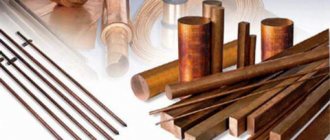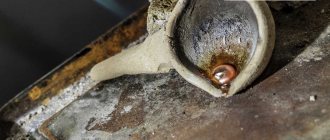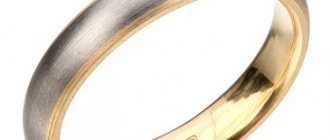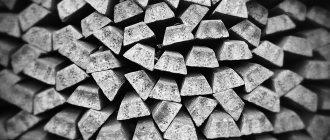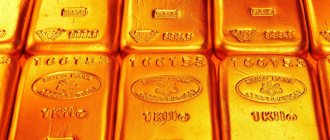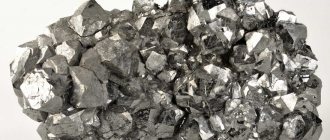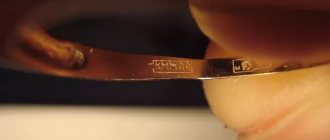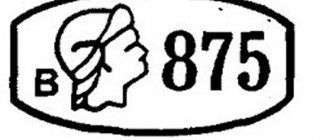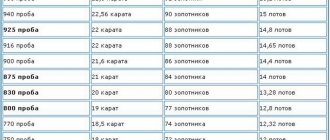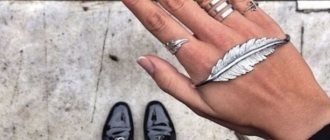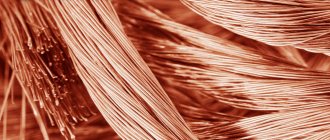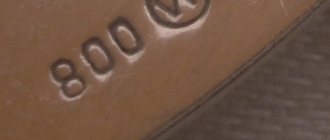Silver (argentum) is a metal that has been known to man since ancient times. In nature, silver occurs in the form of nuggets. The metal has a number of undeniable advantages - it is easily forged, does not react with other metals, has antibacterial properties, etc. The reserves of silver on the planet are estimated at 570 thousand tons, and the mining of this metal is developed in countries such as Peru , Chile, Mexico and Australia. It is known that silver, like any other precious metal, is not used in its pure form for the production of jewelry, since it is easily deformed. It is for this reason that silver is combined with other metals that give it strength, and such compounds are silver alloys.
Features of pure silver and the value of the metal
Pure silver is a malleable and ductile element that is part of the group of noble metals, which already includes gold, platinum and five other platinum-class metals.
All noble elements share a unique property - they do not react to water, oxygen in the air, or other factors that can lead to corrosion and oxidation.
In its pure form, lunar metal is heavy, it is slightly lighter than lead, but heavier than copper. It has the highest electrical conductivity of all existing metals. It can only be dissolved in nitric, concentrated sulfuric, and hydrochloric acid.
The precious metal is used for minting coins, coating contacts of electronic devices, as a food additive, in the production of mirrors, and as a disinfectant. The areas of application are constantly expanding.
Silver bars
The jewelry industry accounts for about 20% of global silver production. In this field, various impurities are added to pure precious metal to improve its wear resistance.
The value of silver as a material for jewelry is as follows:
- It has excellent casting qualities and is amenable to any processing techniques;
- Organically combines with precious minerals;
- Capable of neutralizing bacteria and substances harmful to humans;
- Low cost;
- Has a universal shade suitable for any color;
Chemistry
Silver is stable in water, practically does not react with oxygen in the air at room temperature, but due to the presence of hydrogen sulfide in the air, over time it becomes covered with a thin dark coating of silver sulfide. Silver also reacts with ozone, forming a coating of silver oxide. This is the very darkening that is considered the main drawback of this metal.
Copper, which is the most common alloy for silver alloys, also forms a coating of copper sulfide. The higher the copper content in the alloy, the faster the product will darken, and the lower, the less susceptible the alloy is to tarnishing, so alloys from 875 to 960 are considered the most stable.
Ligature is an alloy of two or more components that is added to a precious metal to bring the jewelry alloy to a certain standard, change the color of the alloy, and also impart various useful properties. The process of adding a ligature is called doping.
Silver dissolves in nitric and hot concentrated sulfuric acid. Like gold, it reacts with alkaline solutions of cyanide. You will probably never encounter these things. And if you do, be very careful.
The perfect union of silver and copper
Ligatures are various impurities used to give the precious metal greater hardness. The main alloying substance when working with silver is copper. Thanks to copper, the precious metal becomes stronger, while maintaining its ductility and beauty.
The degree of purity of the alloy is reflected in its cost. The purer the material, the more expensive it is.
Copper and Silver
The ideal combination of metals is called sterling alloy. It contains 92.5% pure silver, with the remainder being copper. This alloy is one of the most expensive and in demand.
This union of copper and silver is ideal for creating jewelry: necklaces, chains, pendants, rings, earrings. A variety of kitchen utensils, souvenirs, and decorative elements are cast from it.
Features of gold
To understand what jewelry alloy means, it is enough to know that no gold jewelry is 100% made of gold ore.
Typically the elements included are silver, copper, platinum, zinc, cadmium and nickel. The more platinum and silver in the gold mixture, the whiter the jewelry. And copper gives a red tint, giving the jewelry the necessary strength. Gold turns purple when aluminum and gallium are included. A blue tint is obtained by adding rubidium and indium. The bright blue color comes from steel inclusions. And green is obtained using a combination of cadmium and silver.
Scientists are still experimenting with incorporating different metals into the gold “solution” to create unique shades. At the same time, the optimal content of pure gold for jewelry is considered to be 58.5%.
How the alloy is introduced into the alloy
When introducing a ligature, the precious metal is first melted. Copper is introduced in portions so that the alloy does not harden.
If several metals are fused, then sophisticated technology is used. Let's consider it using the example of melting silver with copper, zinc and cadmium.
First, each material is rolled out into thin plates. The resulting plates are wrapped in silver sheets, packaged, compressed, and brightened. Then the discolored mass is melted.
The amount of introduced ligature is always strictly fixed. Even small deviations can degrade the performance of the entire alloy. So 1% nickel will increase strength, and 2.5% will make the alloy brittle. If you add more than 8.9% tin to a copper-silver alloy, the material will become fragile and begin to react chemically with oxygen.
Ranking of silver from 600 to 999 samples. Testing according to GOST
The uniform quality standard for silver is established by GOST 6836-80.
The following silver standards exist in the Russian Federation: 800, 8Z0, 875, 925, 960, 999.
GOST prescribes the areas of application of silver alloys. They are ranked by purity; alloys of any composition are suitable for industry. The jewelry industry uses materials containing more than 72% precious metal.
Silver stones
Known silver hallmark systems
As in the case of gold hallmarks, metric and spool (used until 1927) silver hallmarks are known in Russia. In Western Europe and the USA, the so-called karat silver standard is used. You can read about the formula by which a metric hallmark is converted to a spool hallmark and vice versa, as well as what a carat hallmark means, in the article on hallmarks of gold alloys. And below in the table you can see examples of correspondence between samples of different systems.
Hallmark on silver in Russia and abroad
All precious objects produced for sale must have a special mark. Hallmarking is carried out by the Assay Office. The presence of an imprint confirms that the decoration meets the requirements of GOST.
The hallmark has the following structure: first, the hallmark inspection code is placed, then the mark of the hallmark certificate, and then the numerical designation of the sample.
A key feature of marking silver products is that all information about the precious alloy must be inscribed in a figure resembling a barrel.
The marking can be placed in different places, as a rule it is hidden from view:
- On chains and bracelets - next to the clasp;
- On rings - along the inner rim;
- On spoons - on the back of the handle;
- The earrings have a clasp;
Table: properties of standard silver samples according to GOST
| Alloy class | Density g/cm3 | Melting point, Co | Brinell hardness, kgf/mm2 | Tensile strength, kgf/mm2 | Relative extension |
| Pure precious metal | 10,З9 | 960 | 35 | 18 | 49% |
| 925 | 10,29 | 910-810 | 68 | Z0 | 29% |
| 900 | 10,З0 | 890-779 | 76 | Z0 | 26% |
| 875 | 10,16 | 810-779 | 76 | Z0 | 33% |
| 800 | 10.1Z | 820-779 | 79 | Z1 | 30% |
| 715 | 10,00 | 799 | 92 | ZZ | 27% |
| 625 | 9,85 | 820-779 | 90 | Z1 | 31% |
| 500 | 9,7 | 805-779 | 85 | 29 | 36% |
Cast silver water block
This work was sent to our “unlimited” article competition and the author received a reward - a branded T-shirt for the site and a Soltek SL-865Pro-775 motherboard.
This material can serve as a brief guide to casting metals for a water block; however, any architectural design features will not be considered. I believe that everyone will decide for themselves what kind of water block design they need: channel, ribs, needles or a combination of all this. Therefore, I will only tell you about the method of obtaining blanks for a water block from copper and silver. I would also like to draw attention to minor discrepancies in different reference books: some data on the properties of metals may not coincide.
What metals are used most often for the manufacture of radiators and heat exchangers? Usually these are aluminum and copper, in rare cases silver is used. What properties do these metals have?
Aluminum
. Silvery-white metal, the specific gravity of which is 2.7 g/cm3. The melting point of aluminum is 658 degrees Celsius. Thermal conductivity 205 W/m*C, heat capacity 920 J/kg*C. In cooling systems, this metal is used quite often, despite its low thermal conductivity. The reason for this is the relative cheapness and ease of processing of aluminum. But aluminum is not very suitable as a blank for a water block - its thermal conductivity is low compared to copper.
Copper
. A viscous, viscous metal of light pink color, the specific gravity of which is 8.9 g/cm3. Melting point 1083 degrees Celsius, thermal conductivity 390 W/m*C, heat capacity 400 J/kg*C. Copper is most common in efficient cooling systems, so let's look at it in more detail. In dry air, copper remains almost unchanged, since the thin film of oxides that forms on its surface, giving copper a darker color, protects it well from further oxidation. In the presence of moisture and carbon dioxide, the copper surface becomes covered with a green coating of copper carbonate. When heated in air, copper turns into black copper oxide, which decomposes at higher temperatures, losing oxygen and turning into cuprous oxide. Chemically pure copper is a rather rare and expensive phenomenon:
This is pure oxygen-free copper for the manufacture of precious metal alloys. Its cost is about 15-20 dollars per kilogram. But more often we deal with technically pure copper: for example, pipes for air conditioners and water supply systems, high-voltage busbars are made from M1 grade copper. The thermal conductivity of such copper is 305–339 W/m*C, see here. This is also a very good indicator.
announcements and advertising
-18,000r on MSI RTX 3070
Earn money by participating in the content of our site
3070 Gigabyte Gaming is sold cheaper than any other
The price of the RTX 3060 Ti MSI has dropped by an order of magnitude
-29,000r on RTX 3080 Gigabyte Gaming
Cool RTX 3080 approaches 150 tr
-14000r on RTX 3070 Gigabyte Aorus
RTX 3070 with a discount of RUB 15,000
Silver
. A soft, malleable metal with a specific gravity of 10.5 g/cm3, melting at a temperature of 960 degrees Celsius. It has the highest thermal conductivity among metals - 420 W/m*S. The specific heat capacity of silver is 250 J/kg*C. Chemically inactive, does not oxidize in air either at normal temperature or when heated. This is because silver oxide is an unstable compound that decomposes when heated. It happens that a dark coating appears on silver objects - this is silver sulfide, formed under the influence of hydrogen sulfide in the air or upon contact with substances containing sulfur compounds. Silver is much more expensive than copper. Silver prices can be found here and here.
Pure silver (fineness 999.9) comes in the form of measured ingots:
And in Australian coins (fineness 999):
Now, having found out the properties of metals, you can begin making a water block.
It’s good if there is a solid piece of copper from which you can make a water block, but what if there is no such piece? I ran into this problem when I decided to make myself a water cooler. This means that first you need to get a piece of copper. How can you make a large piece of copper from small pieces? Only by casting! Well, if you cast, you can try silver, as well as alloys of copper and silver.
Most silver items, such as jewelry, are not made from pure silver, but from silver-copper alloys. Such alloys have increased mechanical strength, which explains their widespread use. I’m not sure about the relevance of using such alloys in water blocks: they are inferior in thermal conductivity to pure silver, but cost about the same. The only alloy, in my opinion, worthy of attention consists of 72% silver and 28% copper. Let me explain why: this alloy has the lowest (779 degrees Celsius) melting point among the silver-copper alloys, so it is easier to work with than, say, copper. The thermal conductivity of this so-called kusil is less than that of pure silver and is 371 W/m*C, according to the manufacturer.
Where do we most often find cast products? In a jewelry store: most jewelry is made by casting from alloys of silver, gold, and platinum. In modern jewelry making, lost wax casting is used. At the same time, the complexity of the future product is limited only by the jeweler’s imagination:
You can read about the lost wax casting process here. Quite difficult, but this method would make it possible to obtain a casting that requires minimal processing, that is, an almost finished water block base with a relief of any complexity. But there is a much simpler way to produce castings than lost wax casting. This is chill casting.
A chill mold is a reusable metal casting mold that allows you to produce castings of the simplest shape. Here is an example of a water block, the base of which was obtained by casting in a chill mold:
This is a processor water block. The base material is silver, the cover is cut from copper sheet 3 mm thick, the fittings are made of copper tube with an outer diameter of 10 mm. The design is completely soldered, all copper parts are tinned. Next I decided to make a water block for the motherboard chipset. Now about how I did it.
The most important question: how to melt metal? You can use a brazing torch:
But such burners are suitable for melting a very small amount of metal - about 30 grams. You can, of course, try an acetylene torch, but a gas welding machine clearly will not fit into the interior of the apartment. What do jewelers use to melt large amounts of metal? Here it is:
This is an electric melting furnace with a maximum heating temperature of 1200 degrees Celsius. It works from a regular 220 V outlet and has a maximum power consumption of 1300 W (a good electric kettle eats more). The furnace is more convenient to use than a torch, because it allows not only to melt metal, but also to heat the melt to a precisely specified temperature: the furnace has a thermocouple and a digital controller that regulates heating according to a given program. Thus, the melting process looks quite simple: the heating temperature, heating rate, and holding time at the given temperature are set. Naturally, the furnace allows you to make any alloys of silver and copper. To do this, you need to measure out the required quantities of pure metals and fuse them with the following flux:
This is a borax-based flux, also used for hard soldering. It is necessary when smelting copper. Pure silver, due to its properties, can be melted without flux.
Now let's do the chill mold. Since the creation of the processor water block, I still have this small piece of silver:
This piece is obtained by melting silver filings in a furnace. For ease of use, it is necessary to give it a different shape - for example, an ingot. The chill mold for producing an ingot is very simple to make. From an iron profile 60 x 40 mm, two pieces about 70 mm long are cut, as well as one piece 5.5 mm thick. Two large pieces of the profile are cleaned of rust - the future walls of the mold, and from a small piece a U-shaped frame with a bell is made - the shape of the future ingot. It looks like this:
The bell on the frame is a profit, it limits the location of shrinkage cavities to this area. Shrinkage cavities are voids that form inside or on the surface of a casting due to a decrease in the volume of the metal during solidification. For pure silver the shrinkage is 5%, and for pure copper it is 4.25%.
Then the frame is placed between two pieces of the profile, and the entire structure is tightened with a clamp:
The thickness of the iron in this profile is 2 mm, respectively, the dimensions of the casting will be limited by the internal dimensions of the frame: 36 x 5 mm and a height of about 50 mm, taking into account the profit. That's it, the mold is ready. You can start melting. Silver is loaded into the furnace crucible, the heating temperature is set to 1150 degrees, the smelting process has begun:
While the furnace is gaining temperature, the chill mold is heated on the gas stove:
This is done so that the molten metal does not undergo sudden cooling when poured into the mold. Also pay attention to the very significant overheating of the metal, which is 1150–960 = 190 degrees. The reason for this overheating is the small heat capacity of silver: due to its small heat capacity, silver hardens very quickly when poured into a metal mold.
After about 15 minutes, the furnace reached the set temperature, the silver melted:
It's time to pour. The chill mold is installed on a large piece of iron profile:
The heating program is switched off, the metal is poured into the mold:
The silver solidifies in a matter of seconds - I was unable to photograph the molten metal in the mold. The picture shows that the form is not completely filled. There may be defects in the casting. Now you need to cool the chill mold. To do this, it is lowered into a bucket of cold water, after a while it is removed from there and disassembled:
Yes, indeed, the casting has minor defects: bubbles are visible in the surface layer of the metal. But this is not scary, the main thing is that there are no significant defects, and the surface layer can be ground off. The profit is sawed off and, after processing with a file, the result is a small silver ingot like this:
The ingot measures 41 x 32 x 4.5 mm. What can be made from it? I decided not to be too clever, because I needed a water block for the chipset. I cut out a frame and a cover from 3 mm copper:
After this, the copper parts were tinned, and the entire structure, assembled into a sandwich, was soldered. Now I already have two silver water blocks, for the processor and for the chipset:
Metal casting opens up very attractive prospects. The production of water blocks from silver and its alloys is becoming really accessible. The possibilities of chill molds are not limited only to casting an ingot: it is possible to manufacture chill molds with an M-shaped protrusion on one of its walls. A casting made in such a mold will have an M-shaped channel. Or, for example, you can make a mold, in one of the walls of which there will be a recess 20 x 20 x 5 mm. In this case, the casting will have a projection that can be turned into ribs or needles.
Yes, there is still work to be done.
AG-cool
Other low grade silver alloys
The lowest silver standard is considered to be 600 marking. It contains only 60% precious metal and has a scarlet tint due to the high copper content.
The use of 500 silver is known; the material was used for minting the royal billon and the German mark.
Technical silver
“Technical” is the name given to the precious metal contained in radio components. It can be found in many objects around a person. For example, a power supply contains about 1.5 grams of technical precious metal.
It is also used in medicine, dentistry, and the space industry. The sample size of such material is 600-650.
Technical silver has a number of positive characteristics:
- The material is soft and flexible;
- Has high electrical conductivity;
- The metal is inert and resistant to corrosion;
- Has a low melting point;
The cost of such a precious metal varies about 60 rubles per gram.
Technical silver plates
"Japanese Bronze" Shibuichi
Shibuichi is a precious alloy in the proportion of 1 part silver and up to 3 parts copper. The word “shibuichi” itself is translated from Japanese as “quarter”.
The material is used to make rings, knife handles, brooches, earrings, and decorative parts of the Japanese katana sword. Products made from Shibuichi are patinated, so it is possible to achieve original shades: blue, green, purple.
Gilt silver
Gold-plated precious metal is usually graded 875 and above. It is coated with a layer of gold several microns thick.
It is widely used for making jewelry, cutlery, and creating souvenirs.
To distinguish gilded silver from gold, you need to examine the markings of the product. Samples 750, 585, 375 can be indicated on solar metal. On silver - 925 or 875.
How to determine a sample by density
To determine the sample of a silver product by its density, you need to prepare a scale and a container filled to the brim with water. First, you need to weigh the jewelry and record the result.
Then it is transferred to a container with water and the volume of displaced liquid is determined. When dividing the mass of the product by the volume of water, the density of the decoration is obtained. You just need to compare the result with the sample table.
Silver lookalikes
The “doubles” are visually indistinguishable from lunar metal, but do not contain precious materials. Known copies are:
Cupronickel
The alloy formula was obtained in 1819. Cupronickel contains nickel, iron and manganese, and is a solid solution that can be easily processed both hot and cold.
Cupronickel has a light silver color, excellent casting properties, and corrosion resistance. Widely used for minting silver coins, creating inexpensive art products, and kitchen utensils. Cupronickel silverware must be silvered, otherwise it will give a metallic taste.
Nickel silver
“German silver” translated from German sounds like “new silver”. The composition includes copper, nickel, zinc.
Nickel silver is cheaper than cupronickel and is widely used for the production of enamel, filigree, wind instruments, and guitar frets. The material has also found industrial application in the production of medical instruments and parts of precision instruments.
The properties of nickel silver and cupronickel are almost identical; nickel silver is distinguished only by the presence of zinc.
Jewelry metal nickel silver
What is good about Shibuichi alloy?
In addition to the generally accepted tested alloys, there are silver compounds containing a high percentage of copper (from 30 to 75). They do not have huge value in the jewelry market, but are used in the manufacture of interesting jewelry. One such alloy is Shibuichi. It is also called “Japanese bronze” in another way, since it was invented by the Japanese, who widely used the ligature in the production of handles for daggers and knives. Now Shibuichi is used to make beautiful brooches, bracelets, rings and earrings. The word shibuichi means "three quarters" because it contains ¾ copper and only ¼ silver. The natural colors of this alloy are pale pink and yellowish white. The beauty of “Japanese bronze” is that when patinated, the material acquires a variety of shades from light gray to chocolate brown. Thanks to them, the products look unusual and fantastically beautiful. Whatever silver alloy men and women choose, they can be sure that the products will delight them with their appearance and shine for a long time.
Protective silver coating for dazzling shine
Silver metal may lose its former luxury and darken. To ensure that the products do not lose their aesthetic appearance, jewelers cover them with a layer of rhodium up to one micron thick.
Rhodium is characterized by an increased temperature of kindling and resistance to any mechanical stress. It does not oxidize and has high reflectivity. That is why rhodium is used as a protective and decorative coating.
Silver items plated with rhodium are close in cost to gold jewelry. Such jewelry work is difficult to repair, resize, or recycle, since soldering destroys the rhodium layer.
In addition to rhodium, wax or a special varnish is used to protect the surface of the product.
How to spot a fake
In Russian jewelry stores, counterfeit silver jewelry is practically never found. However, you can easily stumble upon them when shopping at a fair, market or sales.
To avoid becoming a victim of deception and the owner of an item of dubious quality, you can use a few simple rules.
- If you have a small piece of white chalk, you need to run it over the surface of the product. Contact with silver will cause the chalk to turn black, while counterfeit will have no effect on it.
- To determine the quality of the alloy, you can run a pin across it. If there is no silver in its composition, the resulting strip will be black or red.
The rules described above are highly likely to determine the correct result, but in practice they are of little use, as they damage the surface of the product. This is why other methods are more common when purchasing.
- Hold the product in your fist. If within 1-2 minutes it warms up to body temperature, this is a real precious metal; if it remains cold, it is a fake.
- Press the magnet onto the decoration. Silver will not react to it in any way, unlike iron that imitates it.
Interesting facts about silver
This precious metal has been known to mankind for more than 6,000 years. During this time, many facts related to silver were discovered. Let's look at the most interesting of them.
- The metal kills about 650 types of bacteria, but its excess in the body can lead to poisoning and destruction of DNA molecules.
- At the dawn of civilization, silver was revered by many peoples as a sacred symbol of the Moon.
- The longest silver nugget was found at the Cobalt mine. It was even dubbed the “silver sidewalk” because it was 32 meters long. The weight of the precious piece was 10 thousand tons.
- The dispersal of clouds and other human interventions in weather phenomena became possible thanks to this precious metal.
- Silver is used as a food additive in designer restaurants. It is designated as E174.
- A small amount of this metal is found in the bodies of all mammals, and the largest amount is found in brain neurons.
- Moon metal is considered a symbol of purity. It is supposed to be able to ward off evil forces, which is why religious amulets are cast from it.
- Sea water contains 10 times more silver than gold.
- The precious metal has almost one hundred percent light reflectance. That is why it is used to make cameras and luxury mirrors.
- The largest reserves of lunar metal are located in India.
Metal properties
For at least six thousand years, humanity has known what silver looks like. The white (now we can add metallic to this definition) shine most likely attracted the first people to its nuggets. Initially, argentum found application in the manufacture of weapons and jewelry, but not only.
The properties of argentum noted by ancestors determine its use today:
- Silver was placed in water (or kept in containers made of this metal). The metal killed harmful microbes. Christian priests still use this method now, and there are special products for water purification and Ag-based bactericidal medicines on sale.
- “If I make silver water, I have excellent taste,” the Russian Empress Catherine II noted. Metal ions are still used today in the bottling of mineral waters. It is believed that it gives not only a healing, but also a rejuvenating effect.
- The metal was used as talismans against evil spirits, and weapons made from it were used to fight black forces. Silver amulets are also popular in the 21st century. Any jewelry made from it can be considered as such.
- Ancestors made mirrors from metal. Ag has ideal reflective properties. Nowadays, high-precision mirrors are made from it, which are used in science and technology.
- Despite its refractoriness, silver is very ductile and easy to process. Therefore, jewelry made from it is unique and varied. The finest silver threads are used in optics and electrical engineering.
This is a truly unique metal with rich properties. Previously, shiny coins were placed in milk to prevent it from turning sour longer. Nowadays, some elements for underwater vehicles and spacecraft are made from argentum, which can support enormous loads. Silver will surely take a person into the distant future.
Reviews
I encountered a darkening of my silver ring. I took it to the workshop, the master treated the surface of the jewelry with rhodium. Now the ring does not fade or get scratched, and looks even more attractive than before the procedure.
Masha P., Lviv
Richard N. g, Vladikavkaz
To invest funds, several years ago I purchased a bank silver bar. Pure silver weighs a lot; I didn’t even expect that such a small piece could be so heavy. I store the ingot at home without removing it from the packaging, so as not to accidentally scratch the soft material.
It became interesting how much a silver service that was inherited could cost. I found the mark 916 on the dishes, it turned out that this was a sample from the times of the USSR. Now the service is of historical value, but I decided to keep it as a keepsake.
Vasily P, Voronezh
Grandma's tips
In jewelry, metal is not used in its original, pure form (the same applies to the production of cutlery). Other components are added to the alloy, which give additional strength. The classic option here is copper. To distinguish real silver from a fake, you need to talk not about Ag as such, but about the percentage of its content in the alloy.
of people living today were able to determine the purity of metal without any drugs or devices
- Argentum is very thermally conductive - it heats up quickly and cools down quickly. If you hold it in your fist, it will immediately acquire body temperature. You can put it in boiling water (if the decoration does not have stones) and then pick it up. Real metal will burn, but not for long.
- The product can be rubbed in your palms for several minutes. If the skin remains clean, the alloy is good; if dark traces remain, there are excess impurities (most often zinc).
- Silver ringing is not just a stable phrase. When gently tapped, the jewelry rattles; the argentum vibrates lightly and protractedly. The percussion instrument should be something akin to a knitting needle.
- If you place a spoon made of Ag in the sun, it will brightly reflect the rays and shine. A cheap alloy will give a dull glow, or even a barely noticeable one.
- People with a keen sense of smell (and good experience) distinguished silver by smell. They assured that pure metal smelled of freshness and lily of the valley. Now this method is hardly suitable for everyone - modern perfumery will make even iron smell like roses.
- Argentum has a high density. Even a small product made from it should be felt in your hand. And today it is so easy to distinguish silver from much lighter aluminum.
- Previously, the ring was covered with crumbs of rye bread and left there for two days. If the jewelry noticeably turned black during this time, this was a good sign - the alloy was considered to be of high quality. With today's bread this test may not pass.
- You can try to bend the spoon (plate). An object made of normal argentum will yield quite easily and will have almost no spring. But this method will not give a 100% guarantee: you can also bend a steel device. And it will be difficult to return the item to its original appearance.
All these tests were based on knowledge of the properties of Ag. Knowledgeable people could determine the authenticity of the metal by its appearance. This is probably still available to experienced jewelers.
